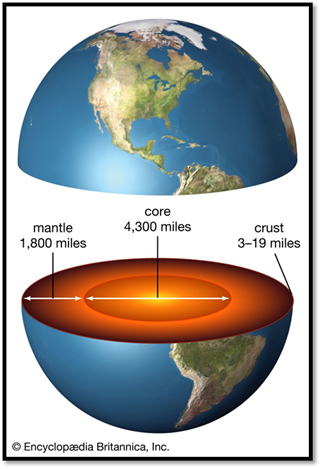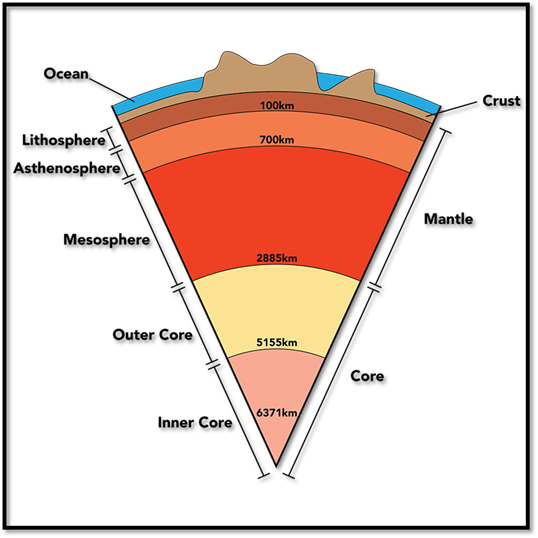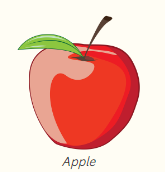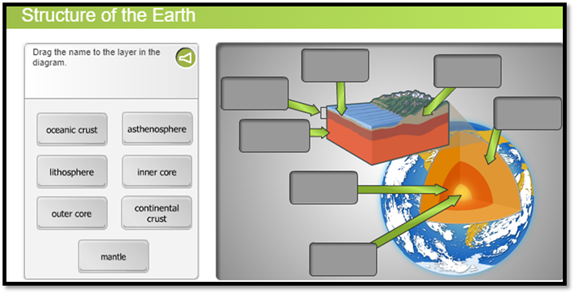Earth's Interior
Introduction
If you have ever eaten a jawbreaker candy, you
know it looks different on the inside than it does on the outside.
In your science
journal, complete and answer the
following questions.
Look at the three objects and answer the questions.
1.
What do you think is inside each object?
2.
How do you know?
Now click on each image, then answer the
question.
3.
Were you right about what was inside each object? Why or why
not?
In this unit, you will explore the inside of
Earth to learn about its different layers.
The Earth is made of various layers:
·
Crust à lithosphere
·
Mantle à lithosphere,
asthenosphere, and mesosphere
·
Core à outer and inner

Earth's interior has three
main layers: a thin, rocky crust; a thick, rocky mantle; and a metallic core.
The measurements provided
are averages.
Let's Practice – Earth's
Layers
Inside
Earth

Earth's Layers
Look at the image above and answer the
following questions in your science journal.
1.
What are the three parts that make up the composition of Earth?
2.
What are the five layers that make up the physical structure of
Earth?
People have always been curious about what is
at the center of the Earth.
Some people have guessed that dinosaurs,
strange creatures, or even aliens might be there. Others thought the
center of the Earth could be a whole different world! In the late 1600s,
the astronomer and geophysicist Edmond Halley said there is
nothing at the center of Earth, just a hollow ball. Some Asian religions refer
to a hollow area below Earth.
Scientists use different methods to find out
what is at the center of Earth—and they have discovered that it is far from
hollow.
They divide up the Earth in two ways:
- Composition – three parts
- crust
- mantle
- core
- Physical structure – five layers
- Lithosphere
- Asthenosphere
- Mesosphere
- outer core
- inner core.
Let's Practice: The Layers of the Earth
Composition
There are three parts of the composition of
Earth: the crust, mantle, and core.
Crust
The outer shell of Earth is the crust. It is
thin and hard. The crust comprises granite, silicon, basalt, aluminum, sodium,
calcium, and potassium.
The crust stretches from just under Earth's
surface to about 18 miles (30 km). This is where you find some of the lithospheres.
Crust temperatures are cooler than the other
layers, about 392°-752° F (200-400° C).
It might seem like the crust is big—and it
is—because this is the part that we can see. But the crust is only about 1% of
the Earth. The mantle and core together make up the other 99%.
Mantle
The mantle gets warmer the farther down you go,
with temperatures from 572°-932° F (300°-500° C).
The mantle is very deep, stretching from 18
miles (30 km) to about 1,118-1,801 miles (1,800-2,900 km). This is where you
find the part of the lithosphere closer to the center of Earth, the
asthenosphere, and the mesosphere.
Oxygen makes up almost half of the mantle
(45%). Nearly a fifth of the mantle is silicon, and nearly a quarter is
magnesium. Other elements in smaller amounts include calcium, aluminum,
potassium, iron, and sodium.
The mantle is denser than the crust because it
has more magnesium and less aluminum.
Core
The innermost layer of Earth is the core, which
includes the outer and inner core.
The core is made of magnetic elements, mostly
of iron with some nickel and probably silicon.
The core can get as hot as 12,632° F (7,000° C)
and stretches from 1,800-3,958 miles (2,900-6,371 km).
In your science journal, answer the following questions.
1. What do we call the
outer shell of the Earth?
2. Which layer covers 80%
of the Earth?
3. What two elements make
up the most of the core?
Let's Practice: Structure of the Earth
Each of Earth's layers has different
properties. Explore how the layers work together to create oceans, build
mountains, and cause earthquakes and volcanoes.
Use the following if it prompts a username and
password: username: jcesc
password: student
Click the image below to
begin.
Physical
structure
There are five layers of Earth: the lithosphere,
asthenosphere, mesosphere, outer core, and inner core.
Lithosphere
Earth's outside layer, the lithosphere,
includes the crust and part of the mantle. People
live right above the lithosphere, which is the coolest layer. From the
surface of the Earth, the temperature increases as you go down to the top of
the asthenosphere, where it is about 2,336° F (1,280° C).
The lithosphere holds many useful materials,
including oil, coal, and natural gases.
Asthenosphere
Under the lithosphere, the asthenosphere goes
down 62-434 miles (100-700 km) below Earth's surface. It is very hot (932° F or
500° C)—so hot that the rocks move around like slow liquid.
The asthenosphere has chemicals similar to the
lithosphere, but it is soft instead of hard because the temperature is close to
the melting point of rock.
This layer helps move and change the Earth's
surface. Because the asthenosphere is soft, the lithosphere can move over
it. The lithosphere sinks at subduction zones and pulls apart at tectonic
boundaries, allowing the land and the sea floor to spread and rise.
Mesosphere
Beneath the asthenosphere is the mesosphere.
The mesosphere is about 434-1,800 miles (700-2,900 km) deep. This is the lowest
part of the mantle.
The mesosphere is similar to the asthenosphere
but gets even hotter (3,632° F or 2,000° C).
With all of Earth on top of it, the mesosphere
is under so much pressure that the rocks are solid and move slower than they do
in the asthenosphere.
Outer
Core
Before getting to the center of Earth, you must
go through the outer core. It stretches from 1,800-3,200 miles (2,900-5,150 km)
into Earth.
This core part is made of liquid iron and
nickel and is very hot—9,032° F (5,000° C). The high temperature makes the iron
and nickel melt into liquid.
Iron and nickel in the outer core are strong
magnets. Scientists think this is why Earth has a magnetic field around it.
Earth needs a magnetic field so that particles from space go around the planet
instead of slamming into Earth—which could hurt living things.
Inner
Core
The center of Earth is the inner core, which is
hot: 12,632° F (7,000° C).
Iron and nickel make up the inner core, but they
stay in solid form and do not melt even in the heat because of the huge amount
of pressure deep inside Earth.
One reason Earth has such a hot core is that a
lot of energy and heat were made when the planet first formed, and the energy
and heat are still there.
Scientists think the inner core goes from
3,200-3,958 miles (5,151-6,371 km).
Because of so much pressure, heat, and miles to
dig through, a real journey to the center of the Earth is impossible.
In your science journal, answer the following questions.
1.
Which layer of Earth would you find oil and coal?
2.
Which layer helps move and change the Earth's surface?
3.
Which layer has solid rocks because of the pressure from the
layers above it?
4.
Which layer do scientists think that the Earth has a magnetic field
because of iron and nickel found on this layer?
5.
Which layer is impossible to go to because of the extreme heat
and pressure?
Let's Practice: Crust, Mantle, or Core



